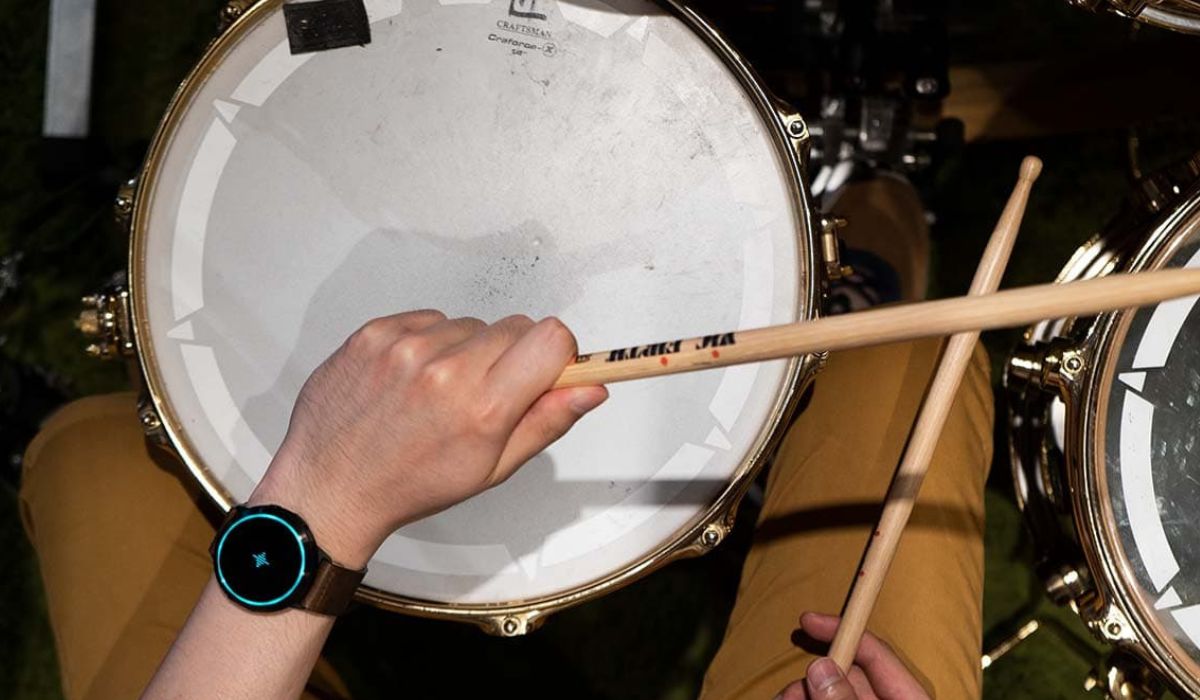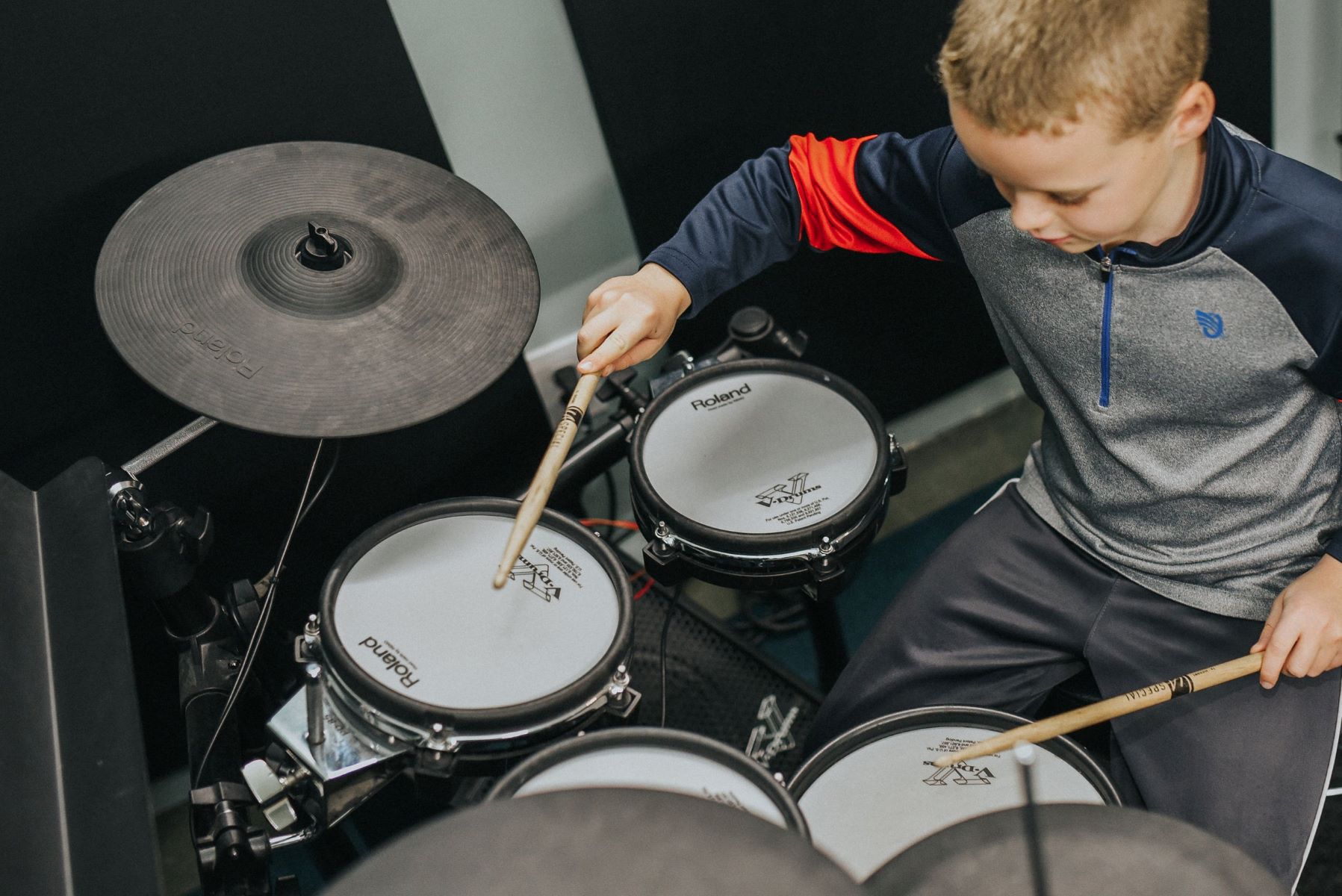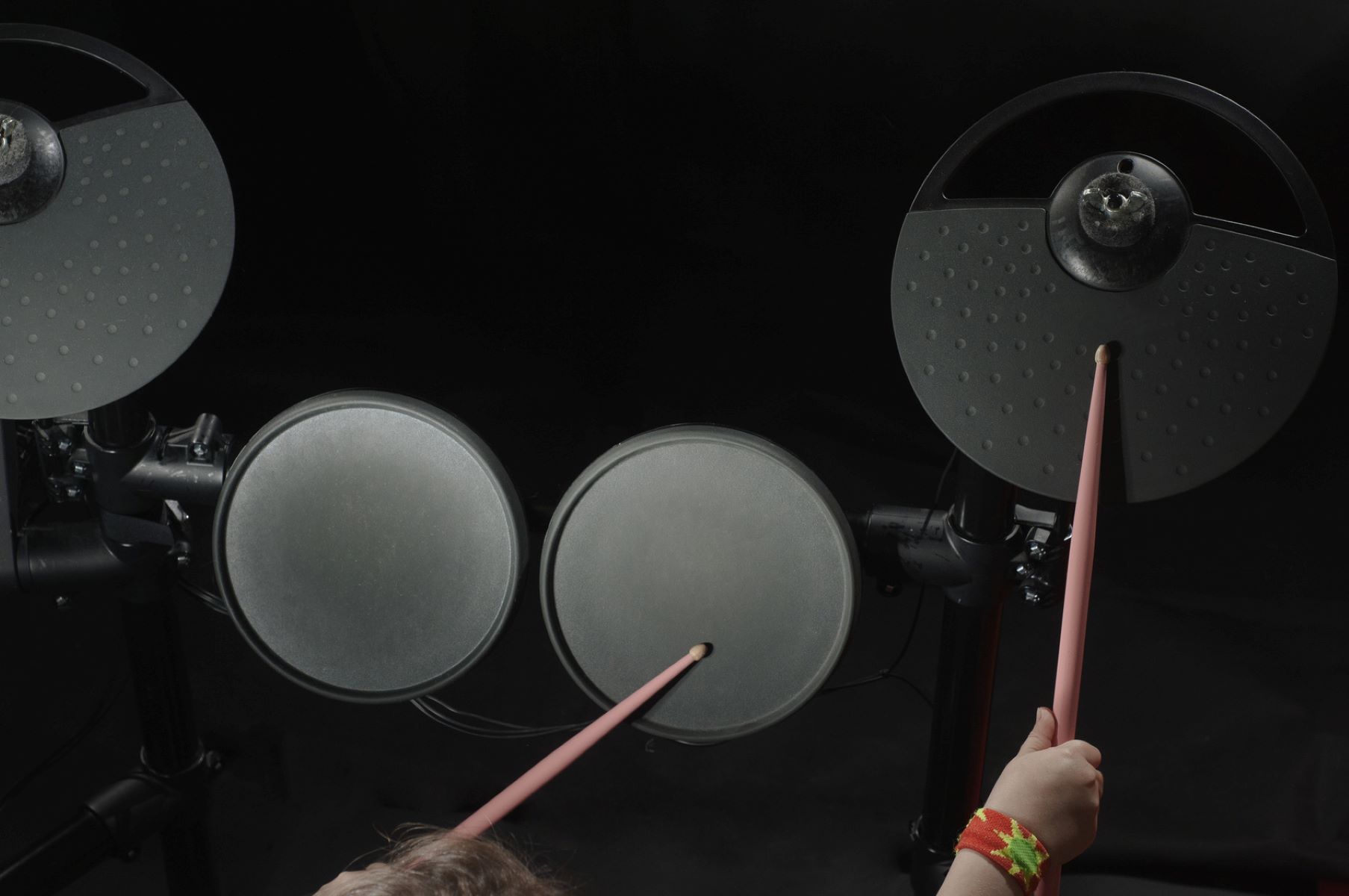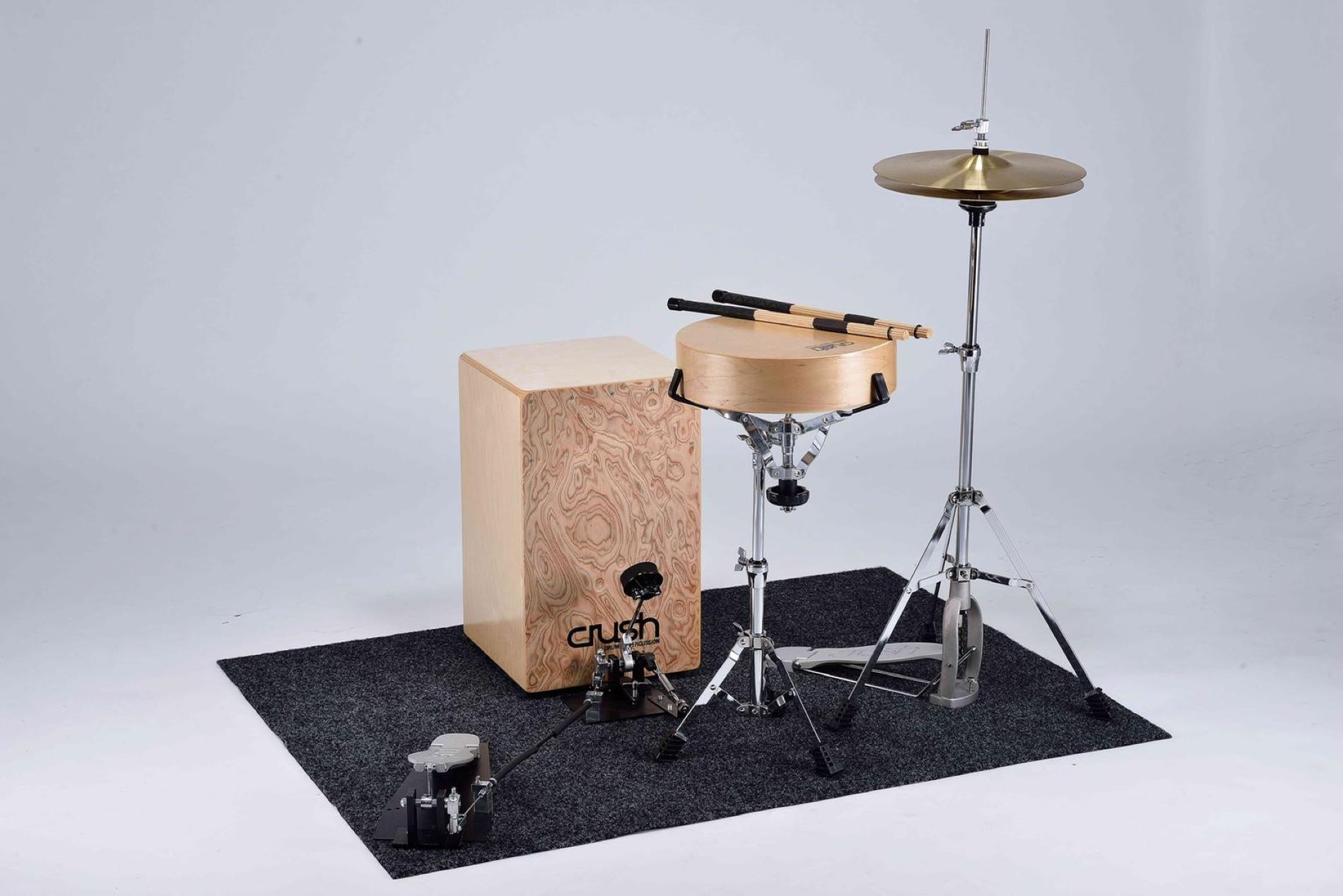Home>Production & Technology>Metronome>How To Play Drums With A Metronome


Metronome
How To Play Drums With A Metronome
Published: January 14, 2024
Learn how to improve your drumming skills by playing with a metronome. Explore different techniques and enhance your rhythm with the help of a metronome.
(Many of the links in this article redirect to a specific reviewed product. Your purchase of these products through affiliate links helps to generate commission for AudioLover.com, at no extra cost. Learn more)
Table of Contents
- Introduction
- Importance of Playing Drums with a Metronome
- Getting Started with a Metronome
- Setting Up Your Metronome
- Basic Metronome Exercises for Drummers
- Advanced Metronome Techniques for Drummers
- Tips for Improving Your Timing with a Metronome
- Common Mistakes to Avoid When Using a Metronome
- Benefits of Practicing with a Metronome
- Conclusion
Introduction
Playing the drums is not just about hitting the drums in a rhythmic pattern, it’s about maintaining consistent timing and precision. And that’s where a metronome comes in. A metronome is a device that produces regular beats at a specific tempo, helping musicians stay on time and improving their rhythmic accuracy.
Whether you’re a beginner drummer or an experienced player, incorporating a metronome into your practice routine can greatly enhance your drumming skills. It not only helps you develop a strong sense of timing, but also improves your overall musicality and ability to play with other musicians.
Playing with a metronome is particularly important for drummers because they are the driving force of the rhythm section. They provide the foundation upon which the rest of the band builds. Without a solid sense of timing, the entire performance can sound disjointed and lack cohesion.
In this article, we will explore the importance of playing drums with a metronome, learn how to get started with one, and discover some essential exercises and techniques to improve your drumming skills. We will also discuss common mistakes to avoid and the benefits of practicing with a metronome.
So whether you’re a beginner looking to establish a strong foundation or an experienced drummer aiming to take your skills to the next level, read on to unlock the power of the metronome and elevate your drumming to new heights.
Importance of Playing Drums with a Metronome
Playing drums with a metronome is crucial for several reasons. Let’s explore the importance and benefits it brings to your drumming skills.
1. Develops a Strong Sense of Timing: One of the fundamental skills any drummer needs to master is maintaining consistent timing. A metronome provides a constant reference point, helping you internalize the beat and play with precision. It trains your internal clock and ensures that you stay in sync with the tempo, no matter what style of music you’re playing.
2. Improves Rhythmic Accuracy: A metronome forces you to play with accuracy and in time. It helps you break down complex patterns into manageable sections, allowing you to focus on playing each note precisely where it should fall. Practicing with a metronome will improve your ability to execute intricate drumming techniques and syncopated rhythms with ease.
3. Enhances Musicality: When you play with a metronome, you develop a stronger sense of musicality. You’ll be able to accentuate beats, create dynamic fills, and experiment with rhythmic variations, all within the framework of the metronome’s steady pulse. This heightened musical awareness will add depth and creativity to your drumming performances.
4. Builds Stability in Ensemble Playing: Drummers are responsible for providing a solid foundation for the rest of the band. Playing with a metronome helps you become a reliable timekeeper, ensuring that your drumming meshes seamlessly with other musicians. It improves your ability to lock in with the bass player, follow the rhythm guitarist’s strumming patterns, and stay in sync with the vocalist.
5. Improves Overall Stamina and Endurance: Drumming requires physical stamina and endurance. By practicing with a metronome, you can gradually increase the tempo over time, building up your endurance and playing at faster speeds without sacrificing stability or accuracy. This will ultimately enhance your performance capabilities during live shows or recording sessions.
In summary, playing drums with a metronome is essential for developing timing, accuracy, musicality, ensemble skills, and endurance. It forms the foundation of your drumming abilities and propels you towards becoming a well-rounded and versatile drummer. So make the metronome your practice companion and witness the transformation it brings to your drumming journey.
Getting Started with a Metronome
Now that you understand the importance of playing drums with a metronome, let’s dive into how to get started using one effectively.
1. Choose the Right Metronome: There are various types of metronomes available, including physical devices, smartphone apps, and online metronomes. Choose the one that suits your preference and budget. Physical metronomes provide a tactile experience, while digital options offer convenience and flexibility.
2. Familiarize Yourself with Basic Terminology: Before using a metronome, it’s essential to understand some basic terminology. Tempo refers to the speed of the beat, measured in beats per minute (BPM). Beat division denotes how the beat is subdivided (e.g., quarter notes, eighth notes). Start by practicing with quarter note beats, and then gradually increase the complexity as you become more comfortable.
3. Set a Comfortable Tempo: Begin by setting the metronome to a comfortable tempo for the exercise or song you’re practicing. It’s important to start with a speed that allows you to play with ease and maintain proper technique. As you progress, gradually increase the tempo to challenge yourself and improve your skills.
4. Begin with Basic Rhythms: Start by practicing simple drumming patterns with the metronome. Focus on playing the drum hits precisely on the beats (usually represented by quarter notes). This will help you develop a solid sense of timing and learn to lock in with the metronome’s pulse.
5. Gradually Introduce Variations: Once you feel comfortable playing basic rhythms, begin incorporating variations. Experiment with different subdivisions, such as eighth notes, triplets, and sixteenth notes. This will enhance your rhythmic accuracy and expand your drumming vocabulary.
6. Practice with Musical Material: While practicing with different exercises and patterns is valuable, it’s equally important to apply the metronome to actual musical material. Play along with songs, tracks, or backing tracks, ensuring that you stay in time with the metronome throughout the entire piece. This will help you develop the ability to play in a musical context and stay consistent even with changing dynamics and tempos.
7. Record and Analyze: Recording yourself playing with the metronome can be immensely helpful. Listen back to the recordings and analyze your timing and rhythmic accuracy. Look for areas where you may be rushing or dragging, and make adjustments accordingly. This self-assessment will enable you to identify areas of improvement and focus your practice sessions effectively.
8. Be Patient and Consistent: Learning to play with a metronome is a skill that takes time to develop. Be patient with yourself and embrace the process. Consistent practice will yield the best results, so make it a part of your regular routine.
By following these steps, you will lay a strong foundation for playing drums with a metronome. Remember to be mindful of your technique, stay relaxed, and gradually challenge yourself by increasing the tempo and incorporating more complex rhythms. The metronome will be your trusted companion on your journey to becoming a more precise and proficient drummer.
Setting Up Your Metronome
Now that you are ready to practice with a metronome, it’s important to know how to properly set it up for optimal results. Here are some key steps to follow:
1. Choose the Tempo: Before starting, determine the tempo at which you want to practice. Consider the song or exercise you are working on and select a tempo that matches the desired speed. Many metronomes allow you to adjust the BPM (beats per minute) to the desired tempo.
2. Set the Beat Division: Next, you’ll want to determine the beat division. This refers to how the beat is subdivided, such as quarter notes, eighth notes, or sixteenth notes. Some metronomes have specific buttons or settings to adjust the beat division, while others may require you to select it manually.
3. Adjust the Volume: Depending on your preference, set the metronome volume to a level that is audible but not overpowering. It should be clear enough for you to stay in sync with the beat without distracting you from your playing. Experiment with different volume levels to find the right balance for your practice sessions.
4. Choose the Sound: Most metronomes offer a variety of sound options. You can select different clicks, beeps, or even drum sounds. Choose a sound that resonates with you and enhances your focus. Some metronomes even allow you to customize the sound, giving you the flexibility to create your own unique click.
5. Practice with Downbeats and Upbeats: Consider adjusting the metronome to play downbeats (the strongest beats) or upbeats (the weaker beats) as you practice. This will help you develop a strong sense of pulse and improve your ability to accentuate specific beats within a measure.
6. Experiment with Subdivisions: Once you’re comfortable with basic rhythm patterns, experiment with different subdivisions. Set your metronome to subdivisions such as eighth notes or sixteenth notes to practice more intricate rhythmic patterns. This will challenge your precision and improve your overall rhythmic accuracy.
7. Utilize Mute Functionality: Some metronomes come equipped with a mute functionality, enabling you to practice silently with visual cues only. This can be beneficial if you want to practice without the sound of the metronome, but still require the visual guide to stay in time.
8. Sync with Other Musicians: If you’re playing with other musicians, it’s crucial to synchronize your metronome with theirs. Establish a common tempo and ensure that everyone is practicing to the same beat. This will promote cohesion and tightness within the ensemble.
Setting up your metronome correctly is essential for effective practice sessions. Tailor the settings to your preferences and the specific requirements of the music you are practicing. By using your metronome effectively, you’ll be able to develop your timing, accuracy, and overall musicality as a drummer. So take the time to familiarize yourself with the various features of your metronome and make it an invaluable tool in your drumming journey.
Basic Metronome Exercises for Drummers
When practicing with a metronome, it’s essential to start with basic exercises to develop a strong foundation of timing and rhythm. Here are some fundamental metronome exercises for drummers that will help improve your skills:
1. Quarter Note Exercises: Begin by setting the metronome to a comfortable tempo and play basic quarter note beats on the snare drum or hi-hat. Focus on hitting the drum precisely on each metronome click. This exercise is excellent for developing a solid sense of timing and building a strong rhythmic foundation.
2. Eighth Note Exercises: Once you’ve mastered the quarter note exercises, move on to eighth note exercises. Set the metronome to the same tempo and play two notes per click. This exercise will help you become more comfortable with subdivisions and improve your ability to play faster and more intricate rhythms.
3. Accent Exercises: Practice accenting specific beats while playing along with the metronome. For example, you can accent the first beat of every measure or alternate between accenting the downbeat and the upbeat. This exercise will enhance your control and precision while adding dynamics and variation to your playing.
4. Syncopation Exercises: Develop your sense of syncopation by playing rhythmic patterns that emphasize off-beat notes. Set the metronome to a slower tempo and explore various syncopated rhythms, experimenting with different combinations of snare, bass drum, and cymbal hits. This exercise will improve your ability to play complex rhythms and add groove to your drumming.
5. Fill Exercises: Utilize the metronome to practice drum fills. Set the metronome to a slow tempo and play a simple drum groove while adding fills at specific intervals (e.g., every four bars). Ensure that your fills are precise and land exactly on the beat. As you become more proficient, increase the tempo and incorporate more complex fills.
6. Speed Exercises: Challenge yourself by gradually increasing the tempo of the metronome. Start at a comfortable pace and gradually push your limits, playing various exercises and patterns at faster speeds. This will enhance your speed, accuracy, and ability to keep up with fast-paced music.
7. Groove Exercises: Practice playing along with different music genres and styles using the metronome as a guide. Choose songs or drum loops that represent various grooves and feels, and play along with the metronome to ensure that you stay in time and maintain a steady rhythm throughout the entire piece. This exercise will improve your ability to lock in with different musical styles and musicians.
8. Odd Time Signature Exercises: Use the metronome to practice playing in odd time signatures. Set the metronome to the desired time signature, such as 5/4 or 7/8, and explore different rhythmic patterns within that framework. This exercise will expand your rhythmic vocabulary and improve your adaptability as a drummer.
Remember to start these exercises at a tempo where you can maintain control and accuracy. As you become more comfortable, gradually increase the tempo and complexity. Practicing these basic metronome exercises regularly will help you develop a solid sense of timing, precision, and rhythmic versatility, setting the stage for more advanced drumming techniques in the future.
Advanced Metronome Techniques for Drummers
Once you have mastered the basic metronome exercises, it’s time to explore some advanced techniques that will challenge your skills and take your drumming to the next level. These techniques will help enhance your timing, coordination, and improvisational abilities:
1. Polyrhythms: Polyrhythms involve playing multiple rhythms simultaneously. Set the metronome to a steady tempo and practice playing different rhythms with your hands and feet. For example, challenge yourself to play triplets on the snare drum while maintaining a steady quarter note beat on the bass drum. This exercise will improve your limb independence and rhythmic complexity.
2. Metric Modulation: Metric modulation involves changing the tempo of a piece by subdividing the beat. Set the metronome to a specific tempo and practice switching to a different tempo while maintaining a steady pulse. This technique is commonly used in jazz and fusion genres and will help you develop versatility in changing time signatures and tempos.
3. Time Displacement: Time displacement involves intentionally playing notes slightly ahead or behind the metronome’s click to create rhythmic tension and add flavor to your playing. Experiment with playing slightly ahead or behind the beat while maintaining a consistent tempo. This technique will develop your ability to play with a more relaxed or more urgent feel as required by the music.
4. Subdivided Clicks: Set the metronome to play subdivisions such as eighth notes or sixteenth notes along with the main beat. This challenges your ability to stay in time with more intricate rhythms while maintaining a consistent pulse. Practice playing different patterns within these subdivisions, incorporating accents and syncopated rhythms.
5. Tempo Modulation: Gradually increase or decrease the tempo of the metronome while playing. This technique helps you adjust to different tempos seamlessly and improve your sense of time and adaptability. Start at a comfortable tempo and gradually increase or decrease in small increments while playing various drumming exercises or grooves.
6. Polymeter Exercises: Polymeter involves playing different time signatures simultaneously. Set the metronome to a specific time signature and practice playing a different time signature on a different part of the drum kit. For instance, play in 4/4 time on the snare drum while playing in 5/4 time on the bass drum and hi-hat. This exercise develops your ability to navigate complex rhythmic patterns and strengthens your sense of pulse.
7. Syncopated Off-Beat Patterns: Set the metronome to accent the off-beats rather than the downbeats. Practice playing syncopated patterns that emphasize the upbeats or the spaces between the metronome clicks. This will help you develop a strong sense of groove, improve your ability to play intricate rhythms, and add musicality to your drumming.
8. Improvisation Exercises: Use the metronome as a foundation for improvisation. Set a steady tempo and practice improvising drum solos or fills while staying in time with the metronome. This will develop your ability to think and play spontaneously within a rhythmic framework, improving your improvisational skills and musical expression.
These advanced metronome techniques will challenge your rhythmic abilities, coordination, and improvisation skills. Incorporate them into your practice routine gradually and focus on maintaining control and accuracy as you explore more complex rhythms. Remember, the metronome is not just a tool for keeping time; it’s a powerful tool for expanding your musicality and pushing the boundaries of your drumming abilities.
Tips for Improving Your Timing with a Metronome
Using a metronome effectively requires more than just playing along with the beat. Here are some helpful tips to maximize your practice sessions and improve your timing with a metronome:
1. Start Slow: When practicing with a metronome, it’s important to start at a slower tempo. This allows you to focus on playing with precision and accuracy. As you become comfortable, gradually increase the tempo to challenge yourself and push your limits.
2. Subdivide the Beat: Instead of just playing on the main beats, try subdividing the beat to enhance your sense of timing. Practice playing subdivisions like eighth notes, triplets, or sixteenth notes while maintaining a steady pulse. This will improve your ability to play complex rhythmic patterns and stay in sync with the metronome.
3. Internalize the Beat: Aim to internalize the metronome’s beat and feel it within your body. This will help you develop a strong sense of timing and groove. Listen and connect with the metronome’s pulse, feeling it in your mind and physically tapping your foot or nodding along to the beat.
4. Experiment with Different Styles: Try practicing with the metronome using different musical styles and genres. Each style has its unique rhythmic characteristics and tempos. By exposing yourself to various styles, you’ll improve your adaptability and broaden your rhythmic vocabulary.
5. Emphasize Dynamics: Use the metronome as a guide to practice playing with dynamics. Experiment with accenting certain beats or playing softly and gradually increasing the volume. This will add musicality and expression to your drumming.
6. Record and Analyze: Record yourself playing with the metronome and listen back to identify areas for improvement. Pay attention to any timing inconsistencies or rhythmic inaccuracies. This self-assessment will allow you to make necessary adjustments and fine-tune your timing skills.
7. Practice with Different Click Sounds: Many metronomes offer different click sounds or tones. Experiment with these options to find the sound that helps you stay focused and connected to the beat. Some drummers may find a traditional click sound effective, while others might prefer a more melodic or percussive click.
8. Play with Other Musicians: While practicing with a metronome is valuable, it is equally important to play with other musicians. Join a band, participate in jam sessions, or collaborate with fellow musicians. Playing with others helps develop your ability to lock in with different rhythms and adjust to variations in tempo.
9. Incorporate Improvisation: Use the metronome as a foundation for improvisation. Set a steady tempo and practice improvising drum fills or solos within the rhythmic framework. This will improve your timing, creativity, and ability to respond spontaneously to musical situations.
10. Stay Relaxed: Finally, remember to stay relaxed and enjoy the process. Tension in your body can affect your timing and overall performance. Maintain a relaxed grip on the sticks, use efficient stick technique, and let the music flow naturally.
By incorporating these tips into your practice routine, you will enhance your timing, groove, and overall musicality. The metronome is a powerful tool for drummers, and with consistent practice and dedication, you’ll be able to achieve a solid sense of timing that will greatly elevate your drumming skills.
Common Mistakes to Avoid When Using a Metronome
While practicing with a metronome can greatly benefit your drumming, there are some common mistakes that drummers often make. By being aware of these pitfalls, you can avoid them and make the most out of your metronome practice sessions. Here are some common mistakes to watch out for:
1. Relying Too Heavily on the Metronome: While the metronome is a valuable tool, it shouldn’t be a crutch. Avoid becoming too dependent on the metronome to the point where you can’t keep time without it. Practice with the metronome, but also spend time developing your internal sense of timing and rhythm.
2. Ignoring Dynamics and Musicality: A common mistake is to focus solely on playing in time with the metronome and neglecting dynamics and musicality. Remember to add dynamics, accents, and other expressive elements to your playing. The metronome should be a guide, but it shouldn’t hinder you from infusing your drumming with nuance and musical expression.
3. Chasing the Metronome: Drummers often fall into the trap of trying to “catch up” to the metronome by rushing and playing ahead of the beat. It’s important to resist this urge and focus on staying exactly in time with the metronome. Practice patience and discipline to maintain a steady tempo without rushing or dragging.
4. Neglecting Subdivisions and Off-Beat Accents: Many drummers solely focus on playing on the main beats indicated by the metronome and ignore subdivisions and off-beat accents. This limits their rhythmic capabilities. Make sure to practice subdivisions, syncopated patterns, and off-beat accents to develop a well-rounded sense of rhythm and timing.
5. Overcomplicating the Exercises: While it’s important to challenge yourself, avoid overwhelming yourself with overly complex exercises right from the beginning. Gradually increase the difficulty level of your practice sessions to build your skills progressively. Master the basics first before diving into advanced techniques.
6. Neglecting Tempo Variation: Drummers sometimes become too accustomed to practicing at a single tempo set on the metronome. It’s crucial to vary the tempo and practice at different speeds. Experiment with slower and faster tempos to improve your ability to play in a wide range of musical contexts.
7. Lack of Self-Evaluation: Many drummers fail to evaluate their own playing while practicing with a metronome. Record your practice sessions and listen back to identify areas that need improvement. Pay attention to timing accuracy, rhythmic precision, and any inconsistencies in your playing. This self-evaluation will help you progress and refine your skills.
8. Not Playing with Other Musicians: While practicing with a metronome is valuable, it’s equally important to play with other musicians. The metronome provides a steady beat, but playing with other musicians introduces variations in tempo, dynamics, and interaction. Collaborating with others enhances your ensemble skills and helps you develop a stronger sense of groove and musical communication.
Avoiding these common mistakes will ensure that you make the most out of your metronome practice sessions. By using the metronome as a tool to enhance your timing and rhythm, rather than relying on it completely, you’ll develop a solid sense of time and become a more versatile and expressive drummer.
Benefits of Practicing with a Metronome
Practicing with a metronome offers numerous benefits that can greatly enhance your drumming skills. Here are the key advantages of incorporating a metronome into your practice routine:
1. Improves Timing: A metronome provides a consistent beat, helping you develop a strong sense of timing. By playing in sync with the metronome, you train yourself to play with precision and accuracy. This translates into tighter rhythms and better timing when playing with other musicians.
2. Enhances Rhythmic Accuracy: Playing along with a metronome improves your rhythmic accuracy by helping you internalize and interpret rhythms more effectively. It allows you to dissect complex patterns into manageable sections, ensuring that each note is played precisely where it needs to be.
3. Develops Consistency: Practicing with a metronome encourages consistent playing. It helps you maintain a steady tempo and avoid rushing or dragging during performances. This consistency is crucial for the overall coherence and tightness of your drumming.
4. Builds Speed and Endurance: A metronome allows you to gradually increase the tempo, pushing your speed limits and building your endurance. By gradually challenging yourself to play faster rhythms while staying in sync with the metronome, you develop the technical abilities needed for more complex drumming styles.
5. Aids in Versatility: Playing with a metronome exposes you to various tempos and time signatures. It helps you become adaptable to different musical contexts and genres. This versatility is invaluable as it enables you to become a more well-rounded and sought-after drummer.
6. Enhances Ensemble Playing: Drummers play a critical role in providing a solid foundation for the rest of the band. Practicing with a metronome improves your ability to lock in with other musicians, follow their lead, and maintain a consistent tempo. This leads to tighter and more cohesive ensemble playing.
7. Fosters Creativity: While a metronome provides a constant beat, it also acts as a canvas for your creativity. It allows you to experiment with rhythmical variations, accents, and syncopations within the framework of a steady pulse. This encourages you to develop your own unique drumming style and musical personality.
8. Builds Confidence: Practicing with a metronome builds confidence in your playing. As you develop a strong sense of timing and improve your rhythmic accuracy, you become more secure in your abilities. This confidence translates into more assured performances on stage or in the studio.
By integrating a metronome into your practice routine, you reap the benefits of improved timing, rhythmic accuracy, consistency, speed, versatility, ensemble playing, creativity, and confidence. Embrace the metronome as an invaluable tool in your journey to becoming a highly skilled and well-rounded drummer.
Conclusion
Incorporating a metronome into your drumming practice routine is a game-changer. It enhances your timing, rhythmic accuracy, consistency, speed, versatility, ensemble playing, creativity, and confidence. By diligently practicing with a metronome, you develop a solid sense of timing and improve your ability to play with precision and musicality.
Starting with basic exercises such as quarter notes and gradually progressing to advanced techniques like polymeter and improvisation, the metronome allows you to push your limits and expand your drumming skills. It trains your internal clock, ensuring that you stay in sync with the beat in any musical context.
However, it is important to avoid common mistakes such as over-reliance on the metronome, neglecting dynamics and musicality, and rushing to keep up with the beat. Instead, focus on incorporating dynamics, experimenting with subdivisions, and staying relaxed in your playing.
Furthermore, practicing with a metronome should not be the sole means to achieve perfect timing. It is essential to also develop your own internal sense of timing and rhythm by playing with other musicians and exploring various musical genres and styles.
Remember, the metronome is not just a tool, but an invaluable companion in your drumming journey. Embrace its power and let it guide you towards becoming a well-rounded, precise, and expressive drummer.
So, whether you’re a beginner drummer looking to establish a strong foundation or an experienced player seeking to refine your skills, make the metronome an essential part of your practice sessions. Embrace the consistency and discipline it brings, and witness how it transforms your drumming to new heights of excellence. Happy practicing!











